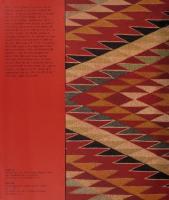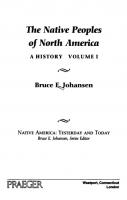The Cultures of Native North Americans 3829029853, 9783829029858
274 13 140MB
English Pages 400 [488] Year 2000
Recommend Papers

- Author / Uploaded
- Christian F. Feest (editor)
File loading please wait...
Citation preview
Editor: Christian F. Feest
The Culture Native North Americans
The diversity of Native American cultures goes far beyond the popular image of the "Indian." The bison, hunters and horseback warriors of the Great Plains, with their wind-blown feather headdresses, make up only a small part of the fascinating world of the peoples and cultures which developed between the icy Arctic and the mountains of northern Mexico. A veritable rainbow of life-styles reaches from the chiefdoms of the eastern forests to the tribelets of California, and from the hunters of northern Canada to the Pueblo peoples who tilled their fields in the dry Southwest. Often still observing old traditions, many of these peoples have survived the 500 years since the first involuntary confrontation with Europeans, contact which brought cultural enrichment as well as death and deprivation. This volume presents the day-to-day life, history, and material and spiritual achievements of North America’s indigenous poeple.
Front Flap Feather Headdress of the Arapaho Chieftain Yellow Calf. The British Museum (London). © AKG Berlin / Photo: Werner Forman Back Flap Sitting Bull and his nephew One Bull (1884). (cf. p. 232) © Palmquist & Jurgens. Library of Congress (Washington, DC)
i ilifps
■,:; r;
IM
• 'trt. *f5 if I’J ffeii ftjrs it H
j* * ■•_
•; a ; -} jf.jjvii'
Uim *w£.t:3
sites
■t™”
f^|
wysaR5TS9;*?r**Pff
\
Umii■■at g§§n
1?-' feai
.,
,
•’
Mg^Srf^} '"‘iM^iIiittti^iiiMl i'i f &' ■■ ? '
fft ■ ■ ,-
^
•
;
',*' _J ; •' ? J •? /-£
mb*
It >\
-
i
w
.
k
Rii
iSiSl!
WwwSltmi
Christian EFeest
Origins and Past of Indigenous North Americans
control high temperatures, ores could not be
"Indians?"
smelted and thus hardly any usable metal tools
"Newer Peoples," from Systematische Bilder Galerie zur Ailgemeinen deutschen Real Encyklopadie (1825-1827). Greater understanding of the American continent revealed to
When in 1492 Columbus mistook the people
produced. In comparison, the absence of true
Europeans the variety and differences of its native peoples,
of the Antilles for natives of India, he could
writing systems was the least of their problems.
whom from the late 18th century onward the new science of
not
In spite of these differences, it can be claimed
encyclopedia shows the inhabitants of northwestern America (5:
have
guessed
how
far-reaching
the
consequences of his error would be. More than
that
some
Native
American
peoples
were
ethnology in particular sought to classify. This early 19th-century Chugash, 6: Nootka) as representatives of "Mongolian and Tartar Tribes," while the famous Mohawk leader Joseph Brant (9)
500 years later, the peoples of the Americas are
culturally closer to Europeans than to some of
and a Mayoruna from the Peruvian Montana (8) are pictured as
still designated as "Indians," as if they were a
their aboriginal neighbors.
representatives of the "American Tribes."
more or less homogeneous population. Nothing could be further from the truth. Compared to
The white conquerors and settlers, however, didn't
see
it
this
way,
and
the
general
word meaning "cannibal," while "Sioux" is the
the diversity of the ways of life that once
designation "Indians" was also an indication of
abridged
distinguished the continent, the "multi-cultural"
their lack of interest in the differences between
"speakers of an incomprehensible language"
America of today seems rather monotonous.
Native American
(in a figurative sense also "snakes").
Pre-European North America was inhabited by
hundreds
from
the
of different
civilizations
of
peoples,
ranging
Central
America
tribes.
Although
we
have
known better for a long time, there had until recently been
term
from
the
remove this
vernacular
of
the
Ojibwa
word
for
In the wake of their belated decolonization, many of the native peoples of North America
and
have asserted their right to their own names,
(Mesoamerica) to the cultures of the Arctic
scholarly vocabularies. Coined more than 100
some of which are now officially used ( more
coast.
years ago, the term
Some of these peoples stood at the
misleading
little attempt to
form
never quite
frequently so in Canada than in the United
established itself and is ultimately just another
States). As most of these self-designations mean
around in smaller family groupings, gathering
misleading generalization. More recent terms
something like "(real) human beings," those of
edible wild plants or hunting game. A more
such as "Native Americans" in the United States
linguistically related, but culturally and politically
sedentary existence, even if only seasonal, was
and "First Nations" in Canada emphasize on the
distinct peoples are often confusingly similar
made possible on the coasts and the banks of
one hand the variety within, but on the other
to one another. By contrast, the designation
rivers and lakes by fishing and hunting sea
the differences between, the modern nation
"Inuit" is now applied even to those "Eskimos"
mammals, and in inland areas by agriculture.
states. Peoples living on either side of the border
whose self-designation is different.
threshold
of forming
states;
others
moved
"Amerind"
However, what these people had in common
have different names depending on where they
when compared to the Europeans who since the
live. The people called Blackfoot in Canada are
16th century had been making their way into
known as Blackfeet in the United States; the
what for them was a new world, was the
Ojibwa of Canada are identical to the Chippewa
absence of certain achievements: the lack of
of the United States (only in Minnesota are they
animal husbandry not only meant that they
called Ojibway or Ojibwe).
depended on hunting for meat, but also that no large
animals were
available
as transport;
Incidentally,
most of the commonly
Languages and writing systems
used
It is no longer possible to determine how many
tribal names are designations used by other
distinct languages were spoken in precolonial
without the use of rotary motion there was
peoples and
neither wheel nor wagon, no potter's wheel, no
were
spinning wheel, no lathe; without me ability to
"Mohawk" is derived from the Narragansett
10
Henry Kammler
not
originally
always
had
meanings which
flattering.
For
instance,
North America - too many have disappeared without trace.
Estimates start at about 500
languages and considerably more dialects.
BERING SEA
Siren ikslu — 0 . Central . Sibenan L
./'Central Sibirian Yupik • 1 ^Naukanski v Yupik
,!>eu.
fiask.au Inupi^
West Greenlandic
A
o
Aleut
East Greenlandic
Beothuk
Northern Algonquian COOSAN^J; Calico ^ lututni
Hidatsa s£> X
Northern Yurok-itif/lSnfi .Paiute „
lvoiJ %
*j.
Arikara
Achumawi
O Q
..
Navajo_^ \
*owa
Kansa Missouri
Osage
I!“P iifcWtT '-“fl.Tiw.
ye, — North Carolina \ Algonquian Woccon
nJ6*^rt /
7,uni
P Ipai —^ Western 3 ffy/y, P»**f ;yaay A-- qjf Maricopa Apache . ^'r° ^ UTOKumeyaay ■Q ;.o Cocopa Upper Tmi.i/X ■ UDDer 4 D AZTECAN Tipai Chiricahua Comanche PaipaiKiliwa Piman
Quapaw
.•~«F«
°SZc
Nanticoke-Conoy
minols - (Nottoway) (Meherrin)
Jicarilla
Walapai
Gahnelino;ii?Sc™0(:hcm™CTU
V
.Nawathinehena
lewa
Caddo v_auuo hita s, n ADD° (K t
?/u>
IW
Tm
ifcriw
ft,
ft
Yuki, isolated in the middle of California, may represent
the
inhabitants
linguistic
of the
heritage
region.
of
II
The Athapaskan
pockets in northwestern California, however,
HL
Urc. ©0S
immigration
in
'Smu
early
are the
result of
6*
the first









